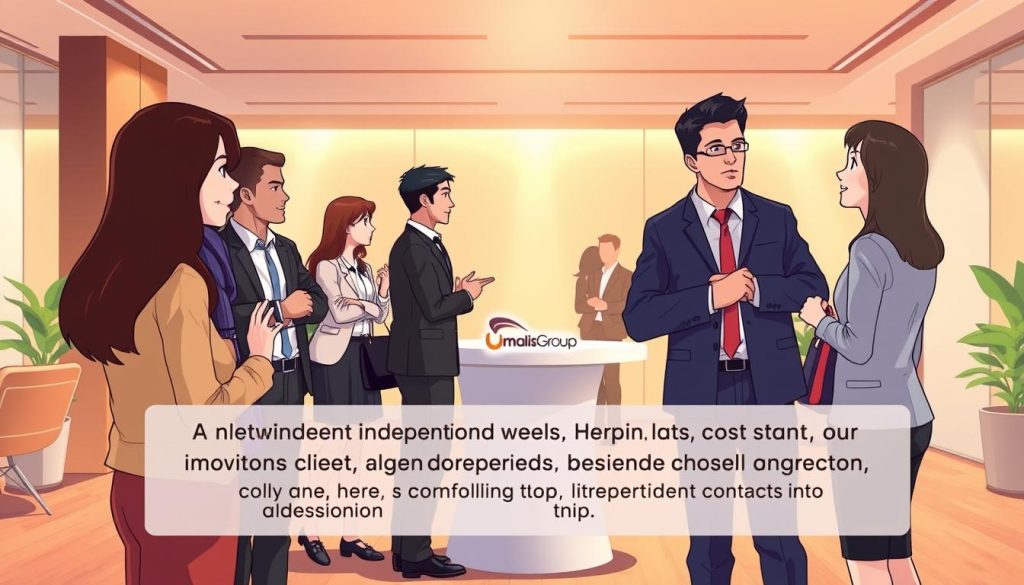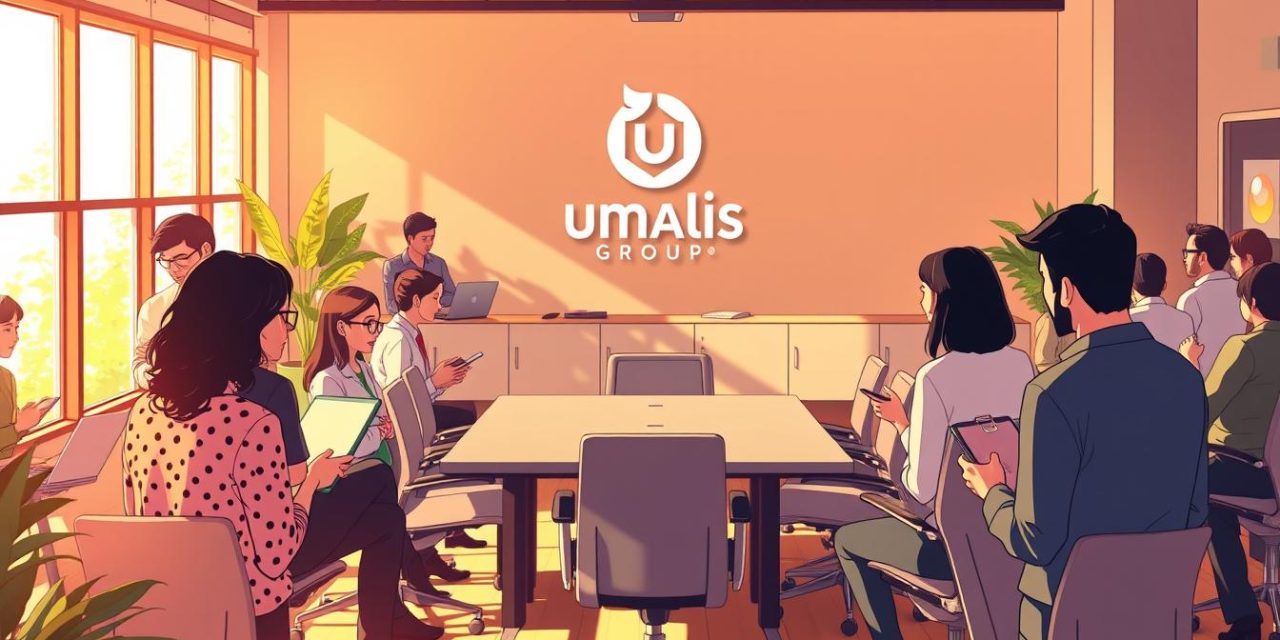Did you know that 70% of independent professionals in France hear about high-value roles through their contacts before they appear publicly?
We set the stage for independents by showing how active networking sustains a resilient career and supports business stability over time.
Visibility in the right industry circles keeps you top of mind for referrals. That means more inbound leads, shorter sales cycles, and stronger positioning as a reliable professional.
Practical focus: your network includes clients, peers, recruiters, associations, and online groups. Each channel—events, social platforms, or associations—plays a distinct role in your long-term success.
We will explain how to balance relationship-building with tracking so you spend your time where ROI is highest. You will learn how structure, follow-through, and intent turn casual contacts into meaningful ties.
Table of Contents
Key Takeaways
- Active contacts make you first in line for new roles and referrals.
- Mix events, online groups, and associations to strengthen your reach.
- Consistent follow-up converts brief meetings into productive ties.
- Prioritize actions that shorten sales cycles and boost inbound leads.
- Align your outreach with your business model and industry dynamics.
Why networking matters for independent professionals in France today
In France today, many high‑value roles never reach public job boards. For independent professionals, this hidden job market makes outreach and presence a practical necessity.
Show up where your industry gathers: LinkedIn, France Travail, job fairs, and targeted events. These channels surface unadvertised job leads and early briefs.
Reputation compounds. Consistent, useful contributions build trust and attract inbound work. Trust and reciprocity then turn brief contacts into long‑term relationships.
- Access to unadvertised contracts and early notice of briefs.
- Introductions from people who know your experience and work.
- Regular exchange of ideas, advice, and best practices that sharpen your skills.
| What | Why it helps | Example |
|---|---|---|
| LinkedIn presence | Raises visibility in your industry | Recommendations and early role mentions |
| Local events | Builds trust face‑to‑face | Job leads and recurring contracts |
| Direct outreach | Targets specific business needs | Shorter sales cycles and referrals |
To learn practical steps to expand your networks, see our guide on networking for freelancers. Invest in steady, value‑led contact and you convert trust into recurring business and career growth.
High‑impact networking opportunities
Choose the right mix of in-person and online events to turn introductions into work. We map the most productive types so you spend time where results follow.
In-person events, meetups, and expos
Conferences, expos, and career fairs put you face-to-face with decision makers. Small meetups from Meetup.com offer informal ways to meet new people.
Online communities and professional social media
LinkedIn and Facebook Groups host daily briefs and collaboration requests. Join a group that matches your industry and interests, then publish helpful posts to stay visible.
Local associations and service clubs
Chambers of Commerce run breakfasts and mentoring that raise local visibility. BNI chapters provide structured referrals, while Rotary and Kiwanis connect you with civic leaders.
- Pathway example: attend a Meetup, follow up on LinkedIn, then join a Chamber breakfast.
- Selection criteria: audience quality, cadence, and practical member support.
- Test quickly: attend as a guest, track outcomes, then commit where you see work.
| Type | What to expect | Best use |
|---|---|---|
| Conferences / Expos | High visibility, industry leads | Branding, large contracts |
| Meetups / Local groups | Casual introductions, repeat contacts | Quick follow-ups, collaborations |
| Chambers / Service clubs | Trusted local referrals, mentoring | Long-term business growth |
Leverage social media to grow your professional network
A targeted social media plan turns passive profiles into active business tools. In France, LinkedIn and Facebook are primary channels to reach recruiters and companies.

LinkedIn: profile optimization, filters, and publishing
Start with essentials: a headline that states client outcomes, a clear banner, featured work, and a keyword-rich summary to boost search visibility.
Use filters for job type, location, and industry to find prospects. Send concise connection requests that reference a specific need. Publish short posts and occasional articles to share ideas and signal skills.
Facebook Groups: niche communities, rules, and value posts
Join relevant groups, read the rules, and add value before promoting services. Daily threads are useful to show expertise and build connections without heavy self-promotion.
- Saved searches and creator tools help you stay visible with less time investment.
- DM etiquette: short intro, clear reason to connect, and a relevant resource link.
- Link portfolios and case studies to signal skills and credibility to new people.
Tip: Track context from posts and convert online replies into 15‑minute intro calls. For practical profile steps, see our guide to optimizing your LinkedIn profile.
Make the most of in‑person and virtual networking events
Choose events that match your client profile and make every interaction count. Start by scanning attendee lists, session topics, and sponsor names to target the right decision‑makers.
Conferences, career fairs, and industry seminars
Prepare: a one‑sentence value proposition, a short case example, and two questions per session. Block your day: three priority booths, two breakout sessions, one social slot.
- Follow up within 24–48 hours; reference the conversation and suggest one practical next step.
- Set event goals (e.g., five quality contacts) and record outcomes to choose which event types to repeat.
Meetup.com and thematic meetups
Use Meetup filters to find groups that match your interests and client niches. Arrive early, join small clusters, and open with an easy question to start a natural conversation.
Virtual event tips: complete your profile, post a short intro in chat, and request 1:1 meetings during breaks to convert chat into calls.
| Type | Focus | Sample agenda |
|---|---|---|
| Conference | High visibility | 3 booths / 2 sessions / 1 social |
| Meetup | Thematic leads | Arrive early / 1 follow‑up |
| Virtual | Targeted calls | Profile + chat intro |
For planning templates and more event tips, see our event planning guide.
Tap into groups and associations that open doors
Local associations and professional groups often act as the quickest way to meet decision-makers in your area. They provide recurring events, mentoring, and city-level visibility that support small business growth.
Chambers and local development associations
Chambers of Commerce host regular events and mentoring programs that raise your profile within the city. Local development associations coordinate district initiatives that can place your work on municipal projects.
BNI and referral-based chapters
BNI’s single-profession model drives focused referrals and accountability through weekly meetings. One-member-per-industry means clearer leads and higher referral quality.
Service clubs and affinity communities
Rotary and Kiwanis cultivate service-led relationships with local leaders and often lead to trusted introductions. Women in Business and similar affinity groups offer training, conventions, and role-model visibility for female entrepreneurs.
- Commitments: fees, attendance, and participation vary—choose by your available time and business goals.
- Test fit: attend as a guest, measure referral quality, then decide.
- Document contacts: map event → 1:1 coffee → project scoping call to turn meetings into relationships.
Navigate France’s hidden job market with strategic networking
Many high-value jobs in France never hit job boards; they start as private referrals. To access them, combine regular platform searches with a calm, structured outreach plan.
Where opportunities surface first
Hidden roles often appear through internal referrals, client communities, or shifts in leadership. Watch for early signals: new funding, tender notices, or executive hires. These signs tell you which companies to follow and when to reach out.
Using platforms like LinkedIn and France Travail to connect
We recommend a weekly search routine: scan France Travail listings, follow priority companies on LinkedIn, and monitor sector feeds. Comment with concise insight to be noticed.
- Request warm introductions from people who know your work.
- Log interactions, set reminders, and close the loop with a clear next step.
- Example outreach flow: follow company → add a practical comment → connect with context → propose a 15‑minute call.
| Action | Signal | Result |
|---|---|---|
| Follow company | Funding or restructuring | Early contact list |
| Engage on LinkedIn | Public thread or post | Visibility to hiring managers |
| Ask for warm intro | Mutual contact | Higher reply rate |
Tip: Blend platform search with off‑platform referrals to maximize exposure to job opportunities that never reach public boards. For practical steps, see our freelance networking guide.
Prepare to network: profiles, positioning, and goals
Start by clarifying the value you bring: a short statement that ties your skills to measurable client results. This positioning helps you open conversations with confidence and purpose.
Set clear, measurable goals: quality conversations per week and proposals per month. Block time in your calendar for outreach and follow-up to protect focus and momentum.
Use a profile checklist: project links, client results, field-specific keywords, and social proof. Update your LinkedIn and portfolio so a quick search shows relevant work.
- Prepare two to three starter questions for events to spark meaningful dialogue.
- Re-engage a short list of former colleagues, clients, and classmates to anchor your professional network.
- Set a weekly cadence for social media touchpoints: comment, share, and publish one original post.
- Map outreach tiers (warm, lukewarm, cold) and tailor messages to raise response rates.
For step-by-step planning and extra advice, see our guide to develop your professional network. We help you convert short efforts into lasting contacts and steady business.
Start conversations and build relationships that last
Begin with curiosity: a focused question invites a true exchange, not a pitch. This approach opens space for a meaningful dialogue and shows respect for the other person’s time.
Smart small talk and thoughtful questions
Comment on one clear insight from the session, then ask a single, specific question. Keep it brief. Listen closely for timelines, priorities, or constraints.
Good questions reveal needs without pressuring. Use them to learn rather than to sell.
Offering help, sharing resources, and being memorable
Small gestures build trust. Offer a short template, a checklist, or a one-paragraph audit that saves time. These actions make you useful and memorable.
- Openers: reference the session insight, ask one thoughtful question, invite a 10‑minute follow-up.
- Listen for cues: note timelines and constraints to make follow-up relevant.
- Give first: share a resource that helps their current need.
| Action | Why it helps | Quick example |
|---|---|---|
| Comment + question | Sparks a genuine exchange | « I liked your point on timing—how do you prioritize projects? » |
| Share a template | Demonstrates value immediately | Send a one-page checklist after the event |
| Log and follow up | Turns brief talks into durable connections | Message referencing the chat + useful link |
Practical tips: remember names with an association, note details immediately, and log contacts in your CRM. Balance asking with giving so people see you as credible and generous.
Follow up, stay in touch, and turn contacts into clients
Follow-ups that add clear value are the bridge between a handshake and a contract. Reply within 48 hours with a short, helpful note that references your conversation and offers a next step. This quick reply raises your profile and keeps you top of mind for future work.
Timely touchpoints
- 48-hour rule: one concise message with a useful idea or resource.
- Three-touch system: idea → short case → timely article to avoid spam.
- Cadence: monthly for warm leads, quarterly for broader networks.
Manage contacts simply
Use digital business cards to exchange details fast. Card-style tools capture date, tags, and notes so context travels with the contact.
Keep a light CRM or spreadsheet to log context, next steps, and review cycles. A clear call-to-action and a brief scoping form convert interest into a real opportunity.
For practical follow-ups and a template library, see our follow-up templates.

Level up: collaborative projects, workshops, and continuous learning
Participating in focused sprints and open-source initiatives is a fast way to build credibility and ties. These formats let you demonstrate skills in real time and produce tangible results you can show clients.
Hackathons and project-based work are a great way to prove problem-solving under pressure. Look for GitHub issues, local innovation events, and association initiatives to join a project and gain practical experience.
Courses and workshops that expand skills and networks
Short courses (Google Digital Garage, Coursera, Scrum Alliance, LinkedIn Learning) teach useful tools and create fresh touchpoints with peers and instructors. A certificate is a great way to signal credibility in your industry.
- Turn project outcomes into case studies to boost your career.
- Quarterly plan: one event, one course, one showcase post to share ideas.
- Keep a small peer group for accountability and ongoing knowledge exchange.
Each activity should add contacts, spark conversations, and lead to new collaborations. For practical planning of local events and how to join groups, see our local events guide.
Conclusion
Conclusion: Close your plan with a clear routine: keep visible in the right media, join targeted events, and follow up promptly so your efforts compound over time.
We remind you that consistent, disciplined networking is a strategic resource for an independent career in France. Align each action with your industry and goals to protect your business pipeline.
Apply this advice now: optimize profiles, attend two targeted events, join one community, and schedule timely follow-ups. Track results, refine your search focus, and reinvest where relationships yield the best returns.
Practical tip: share useful articles, contribute to your community, and keep building small habits—growth comes from steady effort, not bursts.
FAQ
What are the most effective ways for independent professionals to find networking opportunities in France?
Start with a mix of in‑person and online channels: industry conferences, local Chambers of Commerce, Meetup.com groups, LinkedIn communities, and professional associations like BNI. Attend themed meetups or workshops tied to your skills to meet decision‑makers and potential clients. Prioritize regular events where relationships can develop over time rather than one‑off gatherings.
Why does building a professional network matter for freelancers and consultants today?
A good network opens access to the hidden job market, reliable referrals, and partnerships that stabilize income. It also strengthens your reputation, provides market intelligence, and helps you validate pricing and service offers. Trust and reciprocity within a network often lead to repeat work and long‑term collaborations.
How can I use LinkedIn and other social media to grow my professional contacts?
Optimize your LinkedIn profile with a clear headline, concise summary, and portfolio examples. Use filters to identify relevant people, publish helpful posts that reflect your expertise, and join niche groups. On Facebook, join moderated groups related to your field and contribute valuable comments rather than self‑promotion. Consistent, useful content attracts meaningful connections.
What should I prepare before attending an in‑person or virtual networking event?
Define 2–3 concrete goals (meet industry peers, find collaborators, source clients). Update your profile and portfolio, prepare a short value statement about what you offer, and list a few open‑ended questions. Bring digital business cards or a simple contact method to share, and plan timely follow‑ups after the event.
How do I start conversations that lead to lasting professional relationships?
Use smart small talk focused on the event or shared interests. Ask thoughtful questions about the person’s projects and challenges, listen actively, and offer help or relevant resources. Follow up with a personalized message referencing your discussion and a small value‑add (an article, intro, or tool).
What follow‑up strategies convert contacts into clients or collaborators?
Send a prompt, personalized thank‑you within 48 hours. Offer a brief suggestion or resource tied to your conversation. Schedule a short call or coffee to explore collaboration, and use simple contact management—digital business cards or a CRM—to track next steps and remind yourself of commitments.
Which groups and associations reliably open doors for independent professionals?
Local Chambers of Commerce, industry associations, BNI referral chapters, and affinity groups like Women in Business are effective. Service clubs such as Rotary or Kiwanis can broaden civic visibility. Choose groups aligned with your sector and attend consistently to build trust and receive referrals.
How can independent professionals access France’s hidden job market?
Build relationships with hiring managers, consultants, and recruiters via LinkedIn and regional platforms like France Travail. Participate in sectoral meetups and local business events where unadvertised roles are first discussed. Stay visible by publishing short analyses or case studies that demonstrate your expertise.
What low‑cost ways exist to level up skills and network at the same time?
Join workshops, short courses, and hackathons that offer project‑based collaboration. Contribute to open‑source or community projects to gain credibility and contacts. These formats let you demonstrate skills while forming working relationships that can turn into referrals or paid work.
How should I manage contacts and maintain long‑term professional relationships?
Use a lightweight CRM or a spreadsheet to note context, promised follow‑ups, and value you provided. Schedule regular touchpoints—share relevant articles or brief updates—and offer help before asking for favors. Consistent, modest gestures build trust and keep you top of mind.





